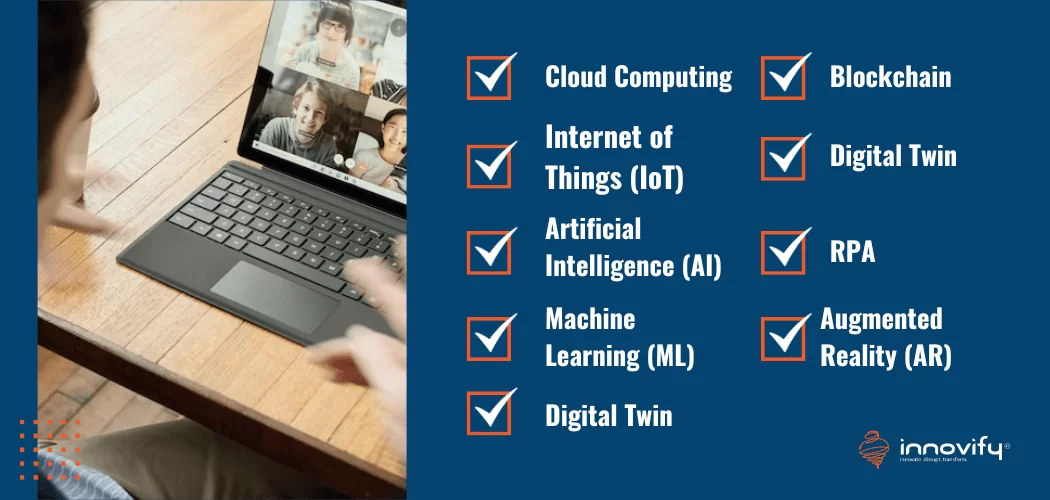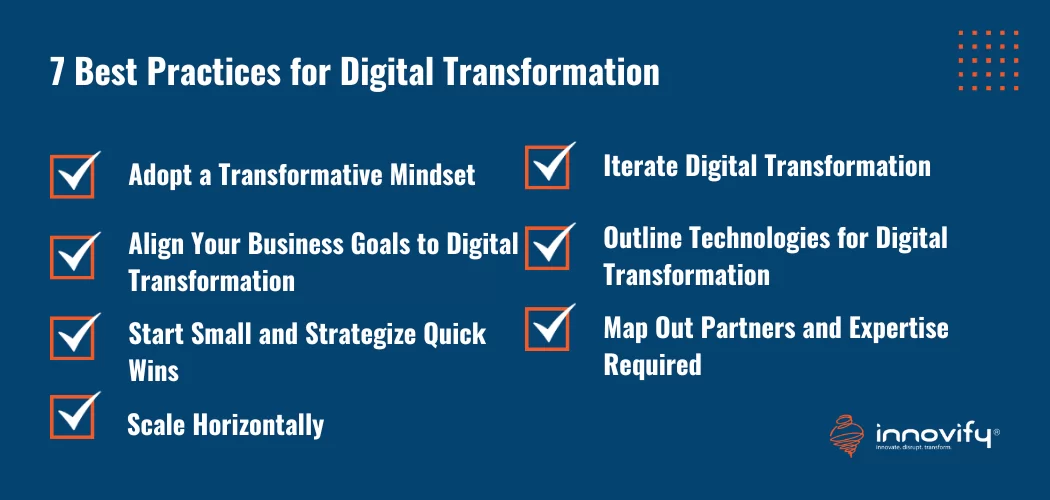AI/ML
7 Best Practices to Strengthen Your Digital Transformation Strategy
Digital transformation can be a game-changer for businesses, but it requires a well-planned and coordinated effort to be effective.
Without a clear strategy, digital initiatives can become disjointed and fail to deliver the desired outcomes.
In fact, a survey conducted by Wipro Digital revealed that over 33% of executives consider the absence of a well-defined digital transformation strategy a significant obstacle to achieving their organization’s complete digital potential.
A digital transformation strategy enables companies to align their digital efforts with key business goals and ensure that resources are used effectively to drive measurable impact.
What is Digital Transformation?
Digital transformation is leveraging technology to bring about significant change across a business.
It’s a way to improve efficiency, increase agility, and unlock new value for everyone involved, including employees, customers, and shareholders.
There are many different paths and stages to digital transformation, and each journey is unique.
For example, a company might use AI or cloud computing to enhance the customer experience or implement machine learning to optimize its supply chain. With the right tools, it’s even possible to predict future customer demand and adjust production accordingly.
But no matter the approach, starting a digital transformation requires a shift in mindset. It’s an opportunity to rethink how business is done from the ground up.
By being open to new ideas, companies can unleash the full potential of digital transformation and unlock a world of possibilities.
Let’s discuss the best practices to start a digital transformation journey.
7 Best Practices for Digital Transformation
Here is how you can get started with your digital transformation journey:
1. Align Your Business Goals to Digital Transformation
The term “digital transformation” can be ambiguous and mean different things to different people.
Unfortunately, many leaders make the mistake of assuming that digital transformation is primarily about adopting new technology and only considering the reasons behind the implementation after the fact. This approach is flawed and has led to many failures.
To ensure a successful digital transformation, it is crucial to identify your business needs and strategic goals and create a digital strategy to achieve them.
To initiate a successful digital transformation, begin with your organization’s long-term strategic goals. This will enable a discussion that prioritizes business value and the creation of a persuasive business case.
For example, Maersk, the world’s largest container shipping company, recognized the need to transform its business to improve its operational efficiency and customer experience.
To achieve this, Maersk invested heavily in technologies, including blockchain, artificial intelligence, and the Internet of Things (IoT), to track its containers and optimize its shipping routes.
As part of its digital transformation process, the company developed a digital platform called TradeLens, which enables all parties involved in global trade to securely and seamlessly exchange information and documentation.
2. Adopt a Transformative Mindset
Digital transformation isn’t about technology; it’s about the people who use it.
Resistance to change is a natural human reaction, so it’s important to anticipate and address push-back when implementing a digital transformation initiative.
Adopting a team mindset and involving representatives from across the value chain, including IT, OT, sales, marketing, and design, is crucial to ensure success.
Organizations can build a strong governance structure that will drive the initiative forward by developing a core team of “cheerleaders” who understand the vision behind the digital transformation strategy.
However, it’s important to remember that any transformation will encounter challenges. Therefore, leaders should foster a culture where mistakes are seen as opportunities to learn, and successes are celebrated and built upon for long-term success.
3. Start Small and Strategize Quick Wins
The road to digital transformation is a never-ending journey of growth and evolution.
The best foot forward in your digital transformation journey is to identify the first proof-of-concept (PoC). This will be the core around which your future initiatives will take place.
Also, digital transformation gains momentum when ROI is proven within a short period with a PoC.
While some projects may have a high ROI, they may take a longer time to implement.
Therefore, starting with quick-win initiatives that can be deployed quickly and show measurable results within six months or less is recommended.
This approach provides early momentum and helps to build support for larger-scale digital transformation initiatives.
4. Outline Technologies for Digital Transformation

To build a strong business case for digital transformation, it is important to have a clear vision of what the organization hopes to achieve. This vision should be aspirational and ambitious, inspiring employees and stakeholders to work together towards a common goal.
However, having a vision is not enough. To turn that vision a reality, organizations need to identify the technologies and tools that will enable them to achieve their goals. These technologies may include:
- Cloud Computing
- Internet of Things (IoT)
- Artificial Intelligence (AI)
- Machine Learning (ML)
- Blockchain
- Digital Twin
- RPA
- Augmented Reality (AR)
- Digital Twin
To achieve your initial digital transformation goals, you may need one or more technologies, some of which may already be used in your organization.
However, to realize the full potential of these technologies, you may need to fill some gaps. It’s important to remember that working with outside vendors like Innovify is often necessary and should be done with a long-term strategy in mind.
Choosing partners with the right expertise and product offerings can accelerate your progress and help you achieve your goals faster. This brings us to the next tenet of digital transformation – partners and expertise.
5. Map Out Partners and Expertise Required
Implementing the right technology for digital transformation is only half the battle; finding the right partner is equally crucial.
Even the most advanced technology can fail to deliver the expected results without the proper expertise.
Moreover, it is also important to avoid “spot solutions” that solve one problem but do not scale across the enterprise. Engaging CXOs in technology decision-making can help align the company-wide strategic vision.
To ensure success, seek out partners that complement and enable your digital transformation vision.
6. Iterate Digital Transformation
To be successful in digital transformation, companies should embrace an iterative approach and continuously refine their processes based on feedback and emerging technology trends.
This means it’s important to approach digital transformation with an agile mindset and iterate your efforts based on feedback from internal and external stakeholders.
Regular communication and feedback loops with colleagues and employees are crucial to ensure that digital transformation efforts are on track and aligned with business goals.
By listening to the thoughts and feedback of stakeholders, digital transformation efforts can be refined and improved over time.
Another important aspect of iteration is the ability to modify processes quickly and easily using digital technology. This agility is a significant advantage of digital transformation compared to traditional approaches, where changes could take months or even years to implement.
This requires a culture of openness to change and a willingness to adapt to new working methods. By doing so, you can stay ahead of the curve and reap the benefits of a digital-first approach to business.
7. Scale Horizontally
As your organization begins to witness the positive outcomes of the first use cases identified in your digital transformation strategy, you can utilize this success to your advantage. Use it to build momentum and foster collaboration around the next phase and long-term objectives.
As digital transformation continues, it opens up new avenues for digital technologies to transform the physical realm.
To expand this positive impact, it is important to explore opportunities for horizontal scaling. This means applying the same strategies to multiple locations.
Additionally, you should consider vertical scaling by integrating additional technologies to augment the existing ones.
Successful Digital Transformation Examples
Now that we’ve discussed the best practices to get you going let’s go through a couple of digital transformation examples.
IKEA
IKEA, the Swedish furniture company, is a prime example of how digital transformation can revolutionize a traditional organization. By leveraging new technologies, the company has enhanced the shopping experience for its customers while also streamlining its operations and reducing costs.
One of IKEA’s notable moves in this direction was its acquisition of TaskRabbit in 2017. TaskRabbit is a platform that enables customers to find people to assist with the assembly or delivery of IKEA furniture to their homes. This service has been particularly helpful for customers who struggle with such tasks.
The company has also incorporated Augmented Reality into its IKEA Place application, which allows customers to preview furniture and virtually “decorate” their homes before making purchases in-store.

Source: IKEA
Another example of IKEA’s digital transformation is the Space10 project, a research and exhibition center. Here, the company showcased the concept of autonomous cars as residential and entertainment spaces, though it has no plans to produce cars itself; it only designs their interiors.
LEGO
LEGO has embraced digital transformation in several ways over the years. One of the earliest examples was their entry into the video game market in 1997, which has since become a key element of the company’s brand promotion and has positively impacted block sales. Moreover, the games are often free, enhancing the brand’s promotional effect.
Recently, LEGO has been exploring 3D printing options, which is a technology that many companies fear as it allows customers to create their own products. LEGO has filed a patent application for this type of printing to offer innovative solutions to its customers.

Source: LEGO
The company has also created a website to gather customer ideas for new block sets. If an idea receives significant support, LEGO will consider producing the kit. This not only stimulates the creativity of brand enthusiasts but also fosters customer loyalty.
LEGO continuously incorporates advanced solutions into its blocks, such as sensors, to keep up with modern technology.
Innovify: Your Trusted Partner in Digital Transformation
Innovify can be the right company to guide your business through a digital transformation because of its experience, holistic approach, and ability to provide customized solutions. By partnering with Innovify, your business can benefit from the expertise and support needed to navigate the digital transformation journey successfully.
We are well-equipped to help your business navigate the complexities of digital transformation. Contact us today!
FAQs
1. What are the 4 pillars of successful digital transformations?
The 4 pillars of successful digital transformation are people, process, technology, and data. These interdependent pillars must be integrated and aligned to achieve a successful digital transformation.
2. What are the 5 keys to digital transformation?
The 5 keys to digital transformation are leadership and vision, customer focus, agility, culture and talent, and technology. These factors are essential to creating a culture of innovation and driving success in digital transformation.
3. What are the 3 key talents for a successful digital transformation?
The 3 key talents for a successful digital transformation are creativity, data analytics, and strategic thinking. These skills are crucial for organizations to leverage digital technologies and transform their operations effectively.
4. What are the 7 key future principles of digital transformation?
The 7 key future principles of digital transformation include customer-centricity, agility, data-driven decision-making, innovation, collaboration, empowerment, and continuous learning. These principles are critical for organizations to thrive in a rapidly evolving digital landscape.




